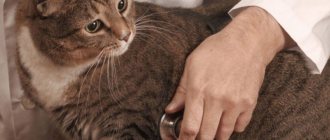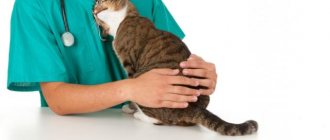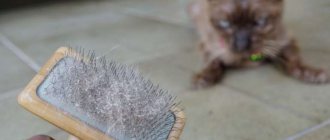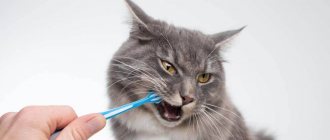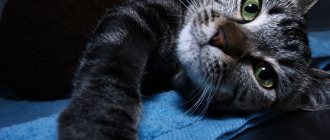27.08.2019
Skin diseases in cats
no comments
8712
Cat chin acne is a common skin condition in the feline species. To be more precise, this is the most common manifestation of acne in cats. It can appear at any age and the gender of the animal does not matter. The disease can get worse, worse, or even be extremely difficult to treat. Signs and symptoms range from barely noticeable comedones (blackheads) to severely inflamed and debilitating pustules. Some cats are not bothered at all, while for others, the pimples are very itchy and painful. Localized hair loss and skin redness are also common.
Causes of the disease
Inflammation of the sebaceous glands in cats is a skin disease called acne. Acne appears in the form of blackheads or blackheads. The most common area of occurrence is the chin and lip area.
There are various reasons why this skin disease appears, the main ones are:
- stressful situations, which result in disruption of the sebaceous glands and the production of large amounts of sebum;
- poor hygiene when licking yourself in hard-to-reach places, such as the chin;
- skin diseases;
- allergy;
- disturbances in the development of the sebaceous glands;
- weak immunity;
- fatty food;
- the porosity of the material of plastic animal feeding bowls, allowing bacteria to accumulate in the pores due to irregular washing of dishes.
The main causes of the disease in cats
It is quite difficult to immediately say why inflammation of the animal’s skin occurs. Therefore, it is extremely important to correctly detect the location of acne in your pet. The place where it appears will indicate the cause of the disease. Mostly in animals, blackheads appear in the area of the lips and chin. Veterinarians identify the following causes of the disease:
- Low stress resistance in the animal. After a change of environment, for example, very often there is a disruption in the functioning of the sebaceous glands.
- Insufficient hygiene, poor cleaning of the animal's chin.
- An unusual change in the functioning of the sebaceous glands, as well as in the cat’s hair follicles.
- The animal's immune system is quite weakened. Acne tends to appear at moments when the body loses all its defenses.
- If low quality plastic utensils are used for food.
These are just a few of the main causes of acne in animals, which can lead to dire consequences. The main requirement for the owner is to closely monitor the condition of his animal.
Which breeds are more susceptible
Skin pathologies in the form of acne are common in cats of different breeds, different ages, and different genders.
Of course, at risk will be those cats who:
- tableware hygiene is not observed;
- the diet is not adjusted towards a balance of microelements, vitamins and nutrients;
- there is no control over the cleanliness of the skin, including in places that are difficult to lick.
What is acne?
Acne in cats is not a very common disease. Therefore, the appearance of acne in the area of the chin, abdomen, mouth, ears and base of the tail causes some surprise in a person.
This dermatological pathology is associated with improper functioning of the sebaceous glands - as a result, pores are clogged and a serious disturbance in metabolic processes occurs.
The pores are closed by old epithelium, which is glued to new cells by fatty secretions. This causes black or white pimples to form. The type of rash depends on where the blockage occurs and the sebaceous plug appears - inside or outside the pore. If the process is not accompanied by infection, the skin problem may disappear on its own.
Main symptoms
In the early phase, acne appears as black dots, which can be confused with dirt or sand in the fur. If you do not pay attention to the changes that have arisen in your pet’s appearance, then the next phase will be redness of the skin and swelling of the affected area.
The pet begins to itch, wounds with bloody discharge may appear at the site of scratching, and if the cat is not treated at the initial stage, the skin disease will progress and reach the appearance of ulcers, and in some cases, to patchy baldness.
If symptoms of itching, restlessness and skin rashes appear in your pet, you should immediately contact a veterinary clinic to have your animal examined.
Is it worth it to self-medicate?
Many owners use lotions and scrubs to relieve painful itching in their pet. The use of such medications can lead to poor health. Black spots on the chin should be treated only with proven remedies. Home treatments can cause allergic acne .
Treatment should be carried out by a knowledgeable person - a veterinarian. The first signs of acne in cats appear noticeably; after they are detected, it is recommended to visit a specialist. It is he who will competently conduct laboratory tests, make a diagnosis and prescribe treatment that must be followed. Any changes must be agreed upon.
Only by the size of the rash can one determine the degree of complication of the disease. When a cat's acne is at a minimal stage, local treatment of the animal is prescribed, but if the affected skin has reached large proportions, a comprehensive series of actions is applied . When treated by a specialist or at home, you should:
- do not squeeze out existing blackheads and pimples,
- adjust the proper nutrition of your pet, while eliminating all possible allergic sources that serve as irritants,
- Treatment should be carried out until the cat has completely recovered.
It is important to remember the principles of treatment - do not abuse 'folk' remedies. The pet must undergo a course of laboratory tests in order to know the diagnosis for sure. Based on the diagnosis, it will be easier to cure the cat.
Diagnostics in a veterinary clinic
Going to the clinic with your pet is mandatory, since the symptoms of acne are similar in their symptoms to such dangerous diseases as sarcoptic mange (scabies), eosinophilic (linear) granuloma, demodicosis (subcutaneous mite), dermatomycosis (ringworm). The appearance of acne can also be associated with an allergic reaction.
To make an accurate diagnosis, the clinic will take a skin scraping from your pet for analysis. The biomaterial is studied for the presence of bacteria and fungi.
The results of the analysis, if they confirm acne, will allow the doctor to prescribe the correct treatment and recommend that the animal owner eliminate possible household factors that irritate the animal’s skin or make changes to its diet.
Symptoms of acne in cats
1. redness of the skin;
2. the appearance of small cone-shaped pimples with white or black tips, which increase in number and size over time. Black clumps of comedones may look like dirt on an animal's fur;
3. swelling;
4. when the disease enters an advanced stage, nodules and ulcers appear on the skin, and groups of hair follicles become inflamed;
5. itching and pain that bother the animal - the cat scratches the wounds, purulent and bloody crusts appear;
6. baldness.
Diagnosis of acne in cats
I would like to draw the attention of owners to the fact that only a veterinarian can make an accurate diagnosis of the presence of acne in a cat after an examination.
Additional diagnostic tests are of great importance, such as scraping the animal’s skin, analysis for the presence of fungal and parasitic diseases, and in rare cases, a skin biopsy. All this is necessary in order to exclude diseases with similar symptoms - demodicosis, dermatophytosis, allergies, eosinophilic granuloma, scabies.
Treatment method and prognosis
When treating cats for acne, you must:
- follow all doctor's orders;
- exclude excessively fatty foods from the diet;
- if there is a lack of vitamins, include them in the cat’s diet;
- Do not squeeze out blackheads on your cat’s skin;
- replace plastic utensils with glass, ceramic or stainless steel utensils;
- Wash animal utensils used for industrial wet or natural food at least twice a day.
When treating a cat for acne, the owner needs a patient and caring attitude towards recovery. Cat acne is not contagious to people and does not cause pain to the animal if it is not advanced and does not bother the pet with itching. In general, the prognosis for recovery is favorable.
The dangers of cat acne
Pathologies caused by blockage and further inflammation of the sebaceous glands are not always considered by owners to be serious problems. However, acne should not be left unattended.
For the animal itself
The pet experiences great discomfort from the accumulation of black spots on the chin, around the nose, mouth, and at the base of the tail. The cat scratches the affected areas of the body and brings dirt into the wounds. As a result, purulent ulcers and crusts of blood are formed. Pathogenic microorganisms can penetrate through them, causing dangerous infections that are long and difficult to treat.
For man
The skin pathology, which is unpleasant for the pet fluffy, is not contagious to the owner and his family members. Only infections that accompany an advanced form of illness (for example, lichen) can be dangerous to humans. Therefore, it is impossible not to treat and allow further spread of acne throughout the animal’s body.
What to do at home
Like other cat diseases, acne can be treated as prescribed by your veterinarian.
In order for the therapy to give the expected result, the owner needs to understand why the normal functioning of the sebaceous glands on the cat’s body has been disrupted. To do this, it is necessary to follow all the recommendations prescribed by the doctor and, after the course of therapy, establish control over the introduction of new foods, especially fatty ones.
It is important to remember that excess vitamins can also cause acne outbreaks. Therefore, vitamins also need to be given in doses.
It is necessary to monitor the hygiene of the dishes, and also wipe the cat’s chin after eating, which is difficult to lick on its own. You can wipe it with a cotton swab dipped in a decoction of calendula or chamomile.
Effective remedies for rashes in pets
Before you begin home treatment for acne in cats, you need to decide on a list of necessary medications. The best treatment method would be healing shampoos with tar soap. It is these solutions that can provide maximum antiseptic and antiseborrheic effect. It is worth applying the mask regularly. Calendula tincture soaked in a gauze bandage will reduce the severity of the disease in a few days.
A drug for the treatment of acne in cats based on Furacilin is found in Perkutan. A similar prescription can be purchased at any veterinary pharmacy. The main requirement is that contact with the eyes is unacceptable .
When a secondary focus of infection occurs with the appearance of a bloody crust and abscess, antibiotics are used. For the speedy restoration of the skin, preparations with vitamins A and retinol-containing medications will help.
You should use cosmetics at home for treatment only as prescribed by a specialist. It is necessary to exclude all fatty types of food, replacing them with vitamin supplements.
Possible complications
If you do not provide qualified assistance to your cat in a timely manner and allow the formation of blood wounds after scratching acne areas, then a secondary infection may develop on the skin. Damaged skin is a gateway for infection; any fungus or bacteria will complicate the pet’s condition.
The right decision would be for the animal owner to contact the clinic at the initial signs of the disease, avoiding re-infection.
How to properly cleanse your pet's skin with acne
Before you begin the procedures, you need to understand the sequence in which they are performed. To ensure success, let's look at the following step-by-step instructions.
Step #1. Washing the skin
The pet's skin must be cleaned with a specialized shampoo, which we already mentioned earlier. The water should not be hot or cold, so as not to provoke thermal damage to the diseased area of the skin. Make it warm and comfortable for the animal. Gently apply the mixture, lather it gently and wash the animal, removing excess fat and dirt from the surface of its skin.
Wash your pet with a special shampoo
Step #2. Disinfect damaged areas
After you wash your cat, wipe the affected areas with hydrogen peroxide, chlorhexidine, or something similar. However, it is best not to use alcohol for this; its effect is too aggressive.
The pet's skin should be wiped very carefully
Step #3. Steam boils
Steaming boils is done using water that has been boiled and cooled to an acceptable temperature and a cotton napkin. Moisten a cloth with water and apply it to the boils, softening them.
It is prohibited to squeeze boils on a cat yourself; this should only be done by a veterinarian.
Step #4. Applying ointments
At the fourth stage, ointments are applied, which are designed to nourish, moisturize and disinfect the animal’s skin. They are applied generously, but not too much, so as not to clog the pores, thereby provoking the appearance of new spots.
Apply the ointment carefully
Please note: application must be done gently. Otherwise, the use of the drug will have the opposite effect, as you will damage the skin and rub the infection into it.
Instead of output
Cats with acne are likely to have varying amounts of comedones in the affected areas throughout their lives. These lesions may simply be a cosmetic problem that the owner may or may not treat, but may also predispose to a more problematic form in 45% of cases that requires periodic treatment.
Local (external) use of wipes, shampoos and ointments are quite effective. But if this does not help in your case, then there is “heavy artillery” - antibiotics, supplements. But to prescribe the drug, contact your cat with a veterinarian.
Material for the article was provided by veterinarian, dermatologist, allergist Olga Vladimirovna Chechora
Health and beauty to you and your pet!
Methods for eliminating comedones in pets
You can eliminate blackheads in a cat using an integrated approach to the problem. To do this, you should normalize the pet’s diet, eliminating everything harmful to its body, and also carry out deworming, that is, get rid of worms using one of the specialized drugs: Milbemax, Drontal, Dirofen, etc. You can also use topical pharmaceuticals for treatment. applications. Traditional methods will help complement therapy and make it more effective.
To eliminate acne, first of all, it is necessary to deworm your pet using the drug Milbemax or other similar products.
You should start eliminating comedones only after consulting a doctor, since the cause of the pathology can be serious disturbances in the functioning of the body.
Pharmacy and folk remedies
To eliminate acne in adult animals, the drug Percutan can be used. This medication has antibacterial properties, due to which it prevents the proliferation of pathogenic microflora and eliminates the inflammatory process. The medicine is available in the form of a solution for external use. It should be applied with a cotton swab 2 times a day to the affected areas of the skin. The course of treatment should be from 4 to 10 days.
Percutan has an antibacterial effect
Also, the area affected by blackheads can be treated with calendula tincture, which has anti-inflammatory and antiseptic properties. This product can regulate the functioning of the sebaceous glands, reducing fat production. The tincture should be used once a day. The most convenient way to apply the liquid is with a cotton swab. The treatment course should not exceed 4–5 days, since the tincture contains alcohol, which can dry out the skin.
Calendula tincture eliminates inflammation
For treatment, you can also use Furacilin solution, which is active against a wide range of microorganisms. At the same time, bacteria and inflammation are eliminated, due to which comedones gradually disappear. 1 tablet of Furacilin must be dissolved in 1 glass of warm water. Treat the affected area with the resulting liquid 3 times a day for a week.
Furacilin produces an antiseptic effect
It is also possible to use retinol (vitamin A) in the form of ointments and creams. These products include: Differin, Clenzit and others. These drugs should be used with caution, as they can cause severe skin irritation. Apply the ointment with a cotton swab in a thin layer every other day for a week. If your pet experiences itching and redness of the skin, then it is recommended to abandon this method of treatment.
Clensite helps eliminate acne, but can cause irritation
Another effective remedy for eliminating the problem is a solution of methylene blue, which can be purchased at a pharmacy. It soothes the skin by eliminating overactive sebaceous glands. You can treat the affected areas with this product no more than once a day for 3-4 days. If during this time the blackheads have not disappeared, then it is recommended to use another method, since methylene blue slightly dries out the skin.
Methylene blue relieves acne and heals skin
To get rid of comedones, you can also use Chlorhexidine. It eliminates bacteria and excess sebum, while blackheads decrease in size and then completely disappear. The solution should be used no longer than 4–5 days, because it can dry out the epidermis. Wipe the skin with this product 2 times a day using a cotton pad. It is advisable to do this after the pet has eaten.
Chlorhexidine should not be used for more than 5 days
For treatment, you can also use Elite shampoo, which is designed specifically for the treatment and prevention of skin diseases in cats and dogs. This product contains chlorhexidine, plantain and celandine extract, glycerin and provitamin B with allantoin. The shampoo is easily applied to the coat, foams and is washed off with warm water. After just a few uses, acne will disappear.
Elite shampoo is designed specifically for the treatment of skin diseases
In advanced cases, when a secondary infection occurs and suppuration occurs, it is recommended to use tetracycline ointment, which is active against a wide range of pathogenic microorganisms. This remedy should be applied to the site of inflammation 2 times a day. The course of treatment varies from 7 to 10 days. If at the end of therapy there is no result, then you should definitely consult a doctor.
Tetracycline ointment is active against a wide range of bacteria
An excellent folk remedy that helps solve this problem is tar soap. You can use it without fear. This remedy rarely causes allergic reactions, but it eliminates inflammation, fungal and bacterial infections, and also promotes tissue regeneration. Tar soap should be applied to the affected area once a day for a week. In this case, the skin should be pre-moistened with water. After application, you need to wait 5 minutes and then rinse off the product.
Tar soap does not cause allergic reactions
A good effect is produced by chamomile infusion, which eliminates inflammation and skin itching. You will need 1 tbsp. l. dry raw materials, which needs to be poured with a glass of boiling water and left for 1 hour. Then filter the liquid and apply it to the acne area 4 times a day using a cotton pad. The course of treatment is from 10 to 14 days.
Chamomile infusion helps you get rid of blackheads faster
Attention! Under no circumstances should you squeeze your pet's acne. Otherwise, you can provoke increased inflammation and the addition of infection, which will lead to the occurrence of furunculosis.
A friend has a white cat that has black spots on its chin. No one would have thought that animals could also have such a problem. A friend was scared at first because she thought it was not acne, but some kind of serious disease, so she immediately took her pet to the doctor. After examination, the vet said that these were just black dots. Prescribed Chlorhexidine and medicated shampoo. We managed to get rid of the problem in less than a week. Additionally, the doctor recommended paying attention to your pet’s diet.
How to rid a cat of acne - video
Diet food
In order to speed up your pet's recovery, it is recommended to normalize its diet. It is necessary to exclude everything fatty and fried from the cat’s menu, as well as milk and sour cream. It is best to feed your pet a specialized product suitable for a specific breed. In this case, preference should be given not only to dry options, but also to include in the animal’s menu boiled chicken and fish, carrots (which can be mixed with the main food), eggs, cottage cheese, as well as grass, which can be purchased at a veterinary store.
Boiled chicken should be included in your cat's menu
To prevent the problem from occurring regularly, it is important to avoid cheap food that contains a large amount of flavorings, preservatives, and salt, which increases the risk of urolithiasis. This product is very harmful to the pet's immune system. It is recommended to purchase food from the Royal Canin, Purina and other series.
Royal Canin - a line of quality cat food
It is also important that clean boiled water is always available to your pet. At the same time, for watering and feeding, it is better to give preference to iron or glass bowls, since plastic ones emit toxic substances that are harmful to the animal’s body. To strengthen the immune system and to reduce the risk of recurrence of acne, you can include special feed additives containing vitamins (Beaphar and others) in the menu.
It is better to use iron bowls to feed your pet.
To prevent malfunctions in the cat’s body, you should never give your pet bones, raw fish, sweets, as well as onions and garlic.
Can a kitten develop blackheads?
Comedones in kittens occur in isolated cases, since the body of most pets works smoothly up to 6 months. However, if such a problem does arise, then only non-aggressive means can be used for treatment. When eliminating black spots in kittens, you can use chamomile infusion, tar soap, and Furacilin. These products should be used once a day. The exception is chamomile infusion. It can be used 3-4 times a day. The course of treatment is often from 5 to 7 days.
Acne in kittens occurs in isolated cases
The occurrence of acne in kittens should be alarming, as this may be a sign of gastrointestinal dysfunction. It is important to monitor your pet's stool and appetite. If there are no alarming symptoms, then only local remedies can be used for treatment.
List of diseases accompanied by comedones
List of diseases accompanied by comedones:
- Autoimmune diseases. It is believed that sebadenitis leads to the appearance of acne with 100% probability. In general, with this pathology, cats develop severe seborrhea, and acne is only a “side effect.”
- All pathologies of the thyroid gland and other endocrine secretion glands.
Prevention measures
What measures to take to prevent blackheads from appearing again:
- Feed your pet correctly, giving preference only to high-quality and approved products.
- Do not give your animal strong medications without a doctor’s prescription.
- Deworm your pet once every 3 months.
- Monitor the functioning of the cat’s immune system by periodically giving your pet vitamins.
- If any malfunctions occur in the gastrointestinal tract, contact a veterinarian and do not delay treatment.
- Try to protect the animal from stress.
- If the animal often goes outside, it is recommended to bathe it once a month, and also wipe its paws regularly.
- Check your cat for fleas once a week. To do this, you should spread the fur in the area of the withers, belly and hips. If larvae are found, it is imperative to select them or use special means.
- If your cat always has food residues drying out on his chin after eating, it is recommended to wipe this area with wet wipes that do not contain alcohol or harmful fragrances.
If the problem arises from time to time and is an individual feature of the pet’s body, then fresh pumpkin juice can be used for prevention. They should wipe the areas where acne most often appears once a day every few days.
The appearance of blackheads in pets does not affect their general well-being if the provoking factor is harmless. However, the occurrence of acne can often be accompanied by unpleasant sensations. For this reason, it is recommended to begin treatment immediately after identifying the problem. Preventive measures will help prevent the recurrence of the pathology.


